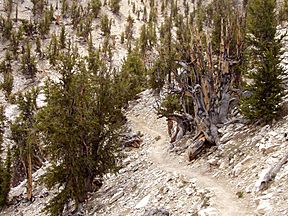Methuselah (pine tree) facts for kids
Quick facts for kids Methuselah |
|
|---|---|

The Methuselah Grove
|
|
| Species | Great Basin bristlecone pine (Pinus longaeva) |
| Location | Ancient Bristlecone Pine Forest, in the White Mountains, Inyo County, California |
| Coordinates | 37°22′46″N 118°09′42″W / 37.3794°N 118.1618°W |
| Date seeded | 2833 BC (age 4857) |
| Custodian | United States Forest Service |
Methuselah is a 4,856-year-old Great Basin bristlecone pine (Pinus longaeva) tree growing high in the White Mountains of Inyo County in eastern California. It is recognized as the non-clonal tree with the greatest confirmed age in the world. The tree's name refers to the biblical patriarch Methuselah, who is said to have reached 969 years of age before his death, thus becoming synonymous with longevity or old age in many European languages including English.
Geography
Methuselah is located between 2,900 and 3,000 m (9,500 and 9,800 ft) above sea level in the "Methuselah Grove" in the Ancient Bristlecone Pine Forest within the Inyo National Forest. The United States Forest Service does not disclose its exact location, although the tree's location is now widely known and available on the internet following a high-profile leak in 2021 after photos of the exact tree were found in a National Geographic article as well as its appearance in a documentary. The tree's location was withheld for years out of fear the tree would be damaged.
Status as oldest known tree
The claim that Methuselah is the oldest known tree is controversial.
Methuselah was 4,789 years old when sampled in 1957 by Edmund Schulman and Tom Harlan, with an estimated germination date of 2833 BC.
Dendrochronologist Matthew Salzer of the University of Arizona has been unable to reproduce Schulman's age estimate, due to a missing core. Salzer's estimate is approximately 4,667 years old.
After the Llangernyw Yew was assessed by David Bellamy as 4,000 to 5,000 years old "using all available data", and the Fortingall Yew, with its former 16 to 17-meter girth, assessed as 5,000 years old, Methuselah may have lost claim to the title of world's oldest non-cloning tree. The Rocky Mountain Tree-Ring Research Old List does not list these trees.
Other bristlecones
Another bristlecone specimen, WPN-114, nicknamed "Prometheus", was more than 4,844 years old when cut down in 1964, with an estimated germination date of 2880 BC. A dendrochronology, based on these trees and other bristlecone pine samples, extends back to about 9000 BC, albeit with a single gap of about 500 years.
An older bristlecone pine was reportedly discovered by Tom Harlan in 2009, based on a sample core collected in 1957. According to Harlan, the tree was 5,062 years old and still living in 2010. Neither the tree nor the sample core could be located after Harlan's death in 2013.
Clonal organisms
Other, longer-lived organisms are clonal colonies, such as a quaking aspen (Populus tremuloides) colony named "Pando" in the Fish Lake National Forest in south-central Utah that has been estimated to be 80,000 years old, although precise estimates of clonal organisms such as this aspen colony are impossible with current technologies, and other scientific attempts to age Pando have estimated it may be much younger; the 11,700-year-old creosote bush (Larrea tridentata) colony, named "King Clone", in the Mojave Desert near the Lucerne Valley in California; and the 9,500-year-old Norway spruce (Picea abies) colony named "Old Tjikko" in Sweden. Methuselah, however, is the oldest known non-clonal organism for which a reliable age has been established, although the Alerce Milenario in Chile (5,484 years old), Llangernyw Yew in Wales (4,000 – 5,000 years old) and especially the Fortingall Yew in Scotland (3,000 – 9,000 years old) have some age estimates exceeding that of Methuselah.
See also
 In Spanish: Matusalén (árbol) para niños
In Spanish: Matusalén (árbol) para niños
- List of individual trees
- List of oldest trees

